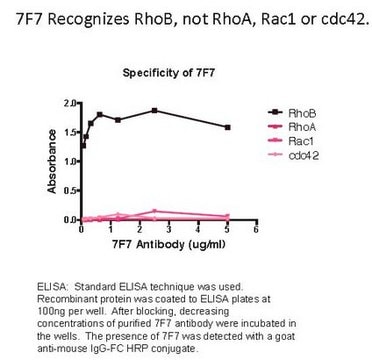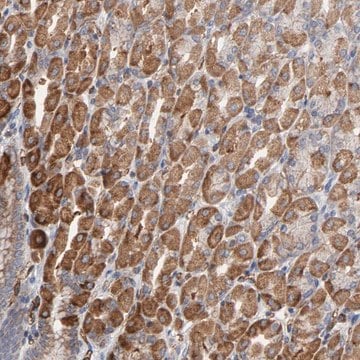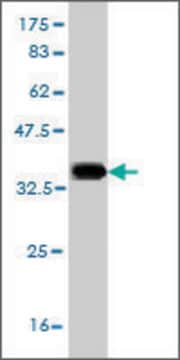MABN679
Anti-BHMT Antibody, clone 8C11H5
ascites fluid, clone 8C11H5, from mouse
Sinônimo(s):
Betaine--homocysteine S-methyltransferase 1
About This Item
Produtos recomendados
fonte biológica
mouse
Nível de qualidade
forma do anticorpo
ascites fluid
tipo de produto de anticorpo
primary antibodies
clone
8C11H5, monoclonal
reatividade de espécies
human
técnica(s)
immunohistochemistry: suitable
western blot: suitable
Isotipo
IgG1
nº de adesão NCBI
nº de adesão UniProt
Condições de expedição
wet ice
modificação pós-traducional do alvo
unmodified
Informações sobre genes
human ... BHMT(635)
Descrição geral
Betaine--homocysteine S-methyltransferase 1, or betaine-homocysteine methyltransferase (BHMT) is the enzyme that is responsible for the metabolic elimination of betaine and homocysteine via their conversion to dimethylglycine and methionine. As such BHMT is one of a handful of key enzymes keenly responsible for betaine levels. BHMT is expressed at high levels in the human liver and kidney, localizing in the ER and cytoplasmic regions. BHMT expression is largely regulated at the level of the gene. BHMT activity becomes essential when folate-dependent remethylation is impaired because of nutritional deficiencies as it then provides the source for methionine. Deficiencies in BHMT can lead a variety of disorders ranging from vascular disease to neural tube birth defects such as spina bifida, fatty liver disease and cirrhosis all which can be linked to betaine metabolism disorders. EMD-Millipore’s Anti-BHMT mouse monoclonal antibody, clone 635, has been tested in western blots using recombinantly expressed BHMT cDNA and by immunohistochemistry on paraffin embedded human liver tissue samples.
Imunogênio
Aplicação
Neuroscience
Developmental Neuroscience
Qualidade
Western Blotting Analysis: A 1:500 dilution of this antibody detected BHMT in 10 µg of HepG2 cell lysate.
Descrição-alvo
Ligação
forma física
Armazenamento e estabilidade
Handling Recommendations: Upon receipt and prior to removing the cap, centrifuge the vial and gently mix the solution. Aliquot into microcentrifuge tubes and store at -20°C. Avoid repeated freeze/thaw cycles, which may damage IgG and affect product performance.
Nota de análise
HepG2 cell lysate
Exoneração de responsabilidade
Not finding the right product?
Try our Ferramenta de seleção de produtos.
Código de classe de armazenamento
12 - Non Combustible Liquids
Classe de risco de água (WGK)
nwg
Ponto de fulgor (°F)
Not applicable
Ponto de fulgor (°C)
Not applicable
Certificados de análise (COA)
Busque Certificados de análise (COA) digitando o Número do Lote do produto. Os números de lote e remessa podem ser encontrados no rótulo de um produto após a palavra “Lot” ou “Batch”.
Já possui este produto?
Encontre a documentação dos produtos que você adquiriu recentemente na biblioteca de documentos.
Nossa equipe de cientistas tem experiência em todas as áreas de pesquisa, incluindo Life Sciences, ciência de materiais, síntese química, cromatografia, química analítica e muitas outras.
Entre em contato com a assistência técnica







